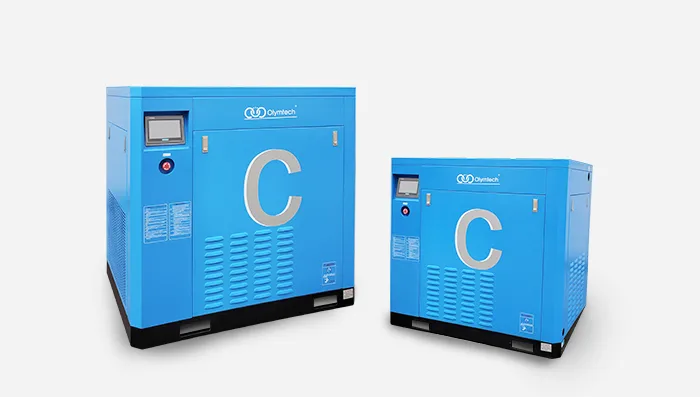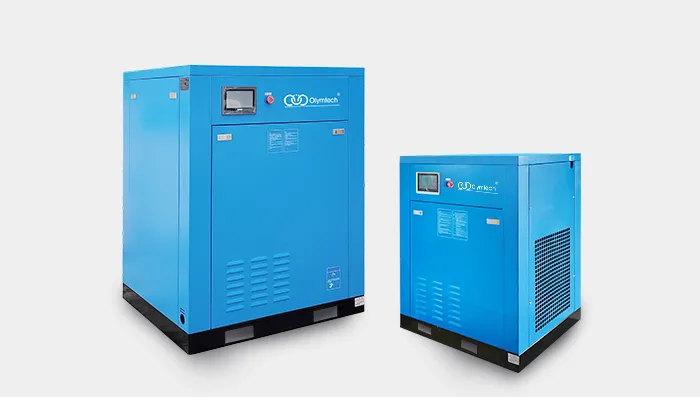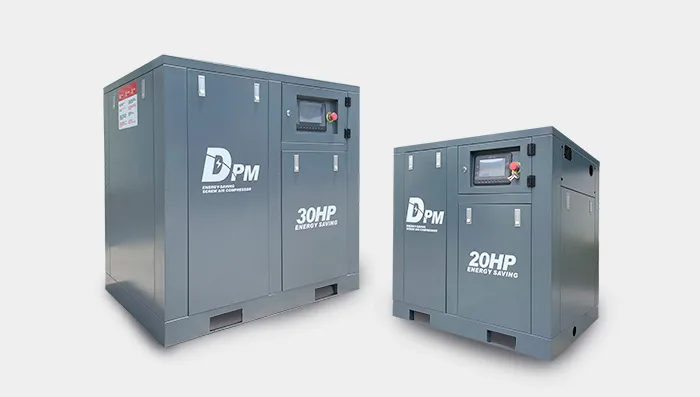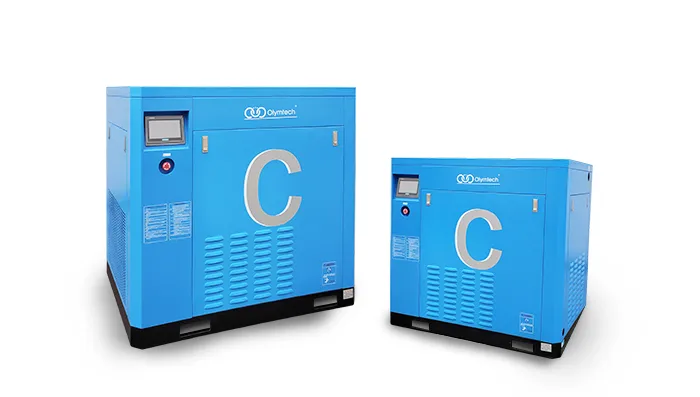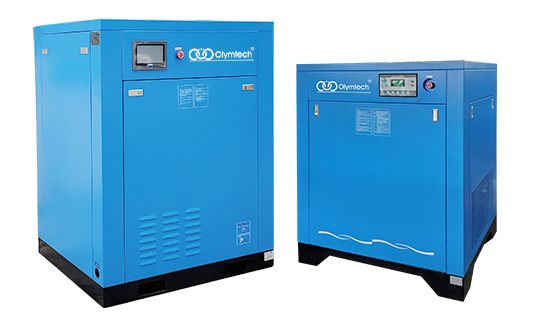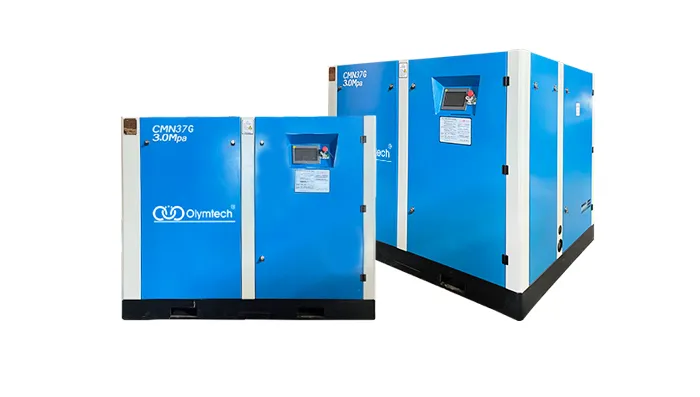Screw compressor is a type of air compressor that uses two rotating screws (also known as rotors) to produce compressed air. Rotary screw air compressors are clean, quiet and more efficient than other compressor types. They are also supremely reliable, even when used continuously. This makes screw compressors the preferred solution for professional and industrial applications across the globe. Here at OLYMTECH we offer total solutions to your business to form a trustworthy partnership.
What is a screw air compressor?
A screw air compressor is a commonly used industrial equipment. Its core components are a pair of intermeshing spiral rotors, usually called male and female rotors. When the male rotor is driven by the motor to rotate, it drives the female rotor to rotate with it. When air enters the air intake of the compressor, it is directed into the tooth slots between the two rotors. As the rotors rotate, the space between the tooth slots gradually decreases, compressing the air in them. Finally, the compressed air is released through the exhaust port for various uses.
What types of air compressors does Olymtech supply?
Variable Speed Screw Air Compressor:
Variable Speed Drive (VSD) is used to adjust the motor speed according to the compressed air demand. It is very efficient and can reduce energy waste during low demand periods.
Two-stage Screw Air Compressor:
It adopts a two-stage main engine design to achieve air compression through a two-stage compression process. Two-stage screw air compressors are designed to reduce energy consumption and improve energy efficiency.
4-in-1 Screw Air Compressor:
This device integrates a screw air compressor, air tank, air dryer and line air filter into a compact unit. It is an all-in-one high-quality air treatment device. Highly integrated and fully functional, it is designed for the diverse industrial needs of small and medium-sized enterprises.
Mono phase Screw Air Compressor:
mono phase rotary screw air compressors use single-phase power, usually 220-240V, and are suitable for residential or light commercial applications where three-phase power is not available. For example, auto repair, woodworking and light industry, etc.
Oil-free screw compressors:
Oil-free technology produces contamination-free compressed air, making them ideal for sensitive industrial applications where air purity is critical, such as the food and beverage or pharmaceutical industries. They meet the needs of a wide range of industrial applications for high-quality, pure compressed air.
High-pressure screw compressors:
2-stage oil-lubricated screw compressors provide a reliable air supply up to 20bar, 30bar, 40bar for high-pressure applications in the most demanding working conditions. Commonly used in the PET industry.
Advantages of screw air compressors
1. Reliable operation and long life:
Rotary screw air compressor
are highly reliable, with fewer parts and no wearing parts. The design life of the main head of a general screw machine is 30 years.
2. Convenient operation and maintenance: Screw air compressors have a high degree of automation, and operators do not need to undergo long-term professional training, and can achieve unattended operation.
3. Good power balance: Screw air compressors have no unbalanced inertial force, and the machine can work smoothly at high speed to achieve foundationless operation.
4. High efficiency:
Screw type air compressor
have strong adaptability and the characteristics of forced gas transmission. The volume flow is almost unaffected by the exhaust pressure. It can maintain a high efficiency in a wide range of working conditions. Without any changes to the compressor structure, it is suitable for a variety of working conditions, so it is easy to finalize and mass produce.
5. Low energy consumption: The slide valve flow adjustment does not require backflow, which can effectively reduce energy consumption.
Applications of screw air compressors
Screw compressors are used in many industries and fields due to their high efficiency, stability and wide applicability.
Industrial applications
Rice Industry: Olymtech's screw air compressors can be used in rice hulling, grading and packaging processes. Provide power sources to drive pneumatic equipment such as pneumatic conveying and screening systems.
Textile Industry: Screw air compressors can drive looms, sewing machines and other textile machinery. Used in air jet weaving technology, it can improve weaving efficiency and fabric quality. In dyeing and finishing processes, screw air compressors are used to spray dyes and complete other processing steps.
Paper and Pulp: In the papermaking field, screw air compressors are used for mixing and conveying pulp, as well as driving pneumatic components on paper machines, such as pneumatic knives and rollers. They can also provide compressed air during drying and cutting processes.
Plastic PET Industry: Screw air compressors are used for PET bottle blow molding, providing stable and clean compressed air. Drive automation equipment such as pneumatic clamps and conveying systems.
Pharmaceutical industry: Use screw air compressors as a power source to give full play to the clean and pollution-free characteristics of compressed air. Provide oil-free compressed air during the production process to ensure that the drugs are not contaminated.
Automotive Industry: Screw air compressors are used for pneumatic tools and automation equipment in the automotive manufacturing process. Used in paint booths to provide high-quality spraying effects. Power pneumatic test equipment and robots.
Laser Cutting: Screw air compressors provide a steady stream of compressed air to laser cutting machines to blow away fumes and debris from cutting and keep the laser cutting head cool and clean.
Garages and Vehicle Repair: Screw air compressors are used as a power source for pneumatic tools such as air wrenches, grinders, and spray guns. They are also used for inflating vehicle tires and other repair operations.
Environmental and safety fields
Mine cooling: Screw air compressors are used in cooling systems of underground mines.
Heat pump systems: In heat pump applications, screw compressors are used to extract and release heat.
Research and laboratories
Gas separation: Gases of different concentrations can be separated from mixed gases by screw compressors and separation devices.
Construction and engineering
Outdoor mobile construction operations: Screw compressors are suitable for providing stable compressed air under various conditions to drive pneumatic tools such as pneumatic picks, pneumatic sandblasting and rock drills.
Other fields
Refrigeration and air conditioning systems: Screw compressors are used as core components in refrigeration and air conditioning systems to achieve temperature control.
Gas boosting: Applications in gas turbine fuel gas boosting, natural gas gathering and transportation, etc.
How to work a screw air compressor?
Inhalation process:
The motor drives the rotor/internal combustion engine. When the tooth groove space of the master and slave rotors rotates to the opening of the intake end wall, the space is large and filled with outside air. When the intake side end face of the rotor rotates away from the intake port of the shell, the air between the tooth grooves is sealed between the master and slave rotors and the shell, completing the intake process.
Compression process:
At the end of the intake, the closed volume formed by the tooth peaks of the master and slave rotors and the shell decreases with the change of the rotor angle and moves in a spiral shape. This is the "compression process".
Compressed gas and oil injection process:
During the transportation process, the volume continues to decrease, the gas is continuously compressed, the pressure increases, and the temperature rises. At the same time, the lubricating oil that becomes mist due to the pressure difference is sprayed into the compression chamber, thereby achieving the effects of compression, temperature reduction, sealing and lubrication.
Exhaust process:
When the closed tooth peak of the rotor rotates to meet the exhaust port of the casing, the compressed air begins to be discharged until the matching surface of the tooth peak and the tooth groove moves to the exhaust end surface. At this time, the tooth groove space is zero, that is, the exhaust process is completed. At the same time, the other pair of tooth grooves of the master and slave rotors have rotated to the intake end, forming the largest space, and the intake process begins, thus starting a new compression cycle.

 EN
EN

